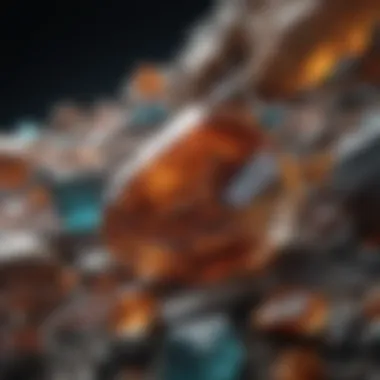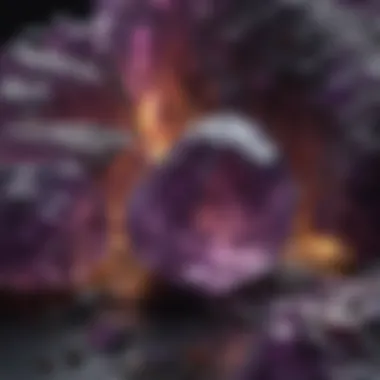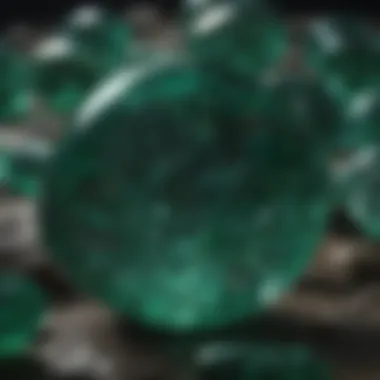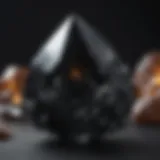Unveiling the Enchanting World of Large Colored Glass Rocks


Rock and Fossil Identification
Welcome to the intriguing world of large colored glass rocks! When it comes to identifying these unique geological treasures, one must consider various aspects. Different types of rocks and fossils can be distinguished by their specific characteristics, which collectors should keenly observe. The tools utilized for identification play a crucial role in the process, aiding enthusiasts in classifying and understanding the intricate nature of these colorful gems.
Collecting Tips and Techniques
For rock and fossil enthusiasts looking to expand their collection with large colored glass rocks, employing best practices is essential. Understanding how to discern prime collecting sites is paramount, as these locations promise exceptional finds. Safely extracting specimens is a delicate procedure that requires precision and care to preserve the integrity of the rocks while bringing them into one's collection.
Preservation and Display
Preserving large colored glass rocks is an art in itself. Various techniques are employed to maintain the rocks and fossils in pristine condition for years to come. Proper storage methods are crucial to prevent damage and ensure longevity. When it comes to displaying these geological wonders, creativity knows no bounds. Enthusiasts can explore innovative ideas to showcase their collection in visually appealing and captivating ways.
Geological Insights
Delving into the geological aspects of large colored glass rocks unveils a wealth of information. Understanding the formations and processes that lead to the creation of these rocks provides insight into their mesmerizing allure. Exploring the historical significance attached to certain rocks and fossils adds a layer of fascination for collectors. Learning about notable discoveries in the field offers a broader perspective on the evolution of our understanding of these stunning geological manifestations.
Prelude to Large Colored Glass Rocks
Large colored glass rocks, a realm of breathtaking beauty and intricacy, hold an allure that transcends mere geological fascination. In this article, we embark on a journey to unravel the enigmatic charm of these luminous treasures. Delving deep into their kaleidoscopic world unveils a tapestry of colors and forms that captivate the senses and challenge conventional perceptions of natural artistry. Dissecting the essence of large colored glass rocks is an endeavor that promises to broaden horizons, cultivate appreciation for the finer details of geological marvels, and spark curiosity in even the most discerning of enthusiasts.
Understanding the Composition
The Role of Various Minerals
Exploring the role of minerals in the composition of large colored glass rocks uncovers a symphony of elements that orchestrate a visual masterpiece. Each mineral brings its own distinctive hue, clarity, and light-play to the tableau, creating a harmonious fusion of colors. The interplay of minerals not only adds depth and complexity to the rocks but also influences their durability and translucency. Understanding the significance of minerals in shaping these geological wonders provides insight into their aesthetic appeal, making them sought-after gems for collectors and connoisseurs alike.
The Influence of Impurities
In the world of large colored glass rocks, impurities wield a subtle yet powerful influence on their overall appearance and desirability. Impurities introduce subtle nuances of color, sparkle, and texture that elevate these rocks from mere glass artifacts to mesmerizing works of art. While traditional quality standards may shun impurities, in the realm of colored glass rocks, they are celebrated for their ability to add character and uniqueness. Embracing the influence of impurities opens doors to a realm of limitless possibilities and an appreciation for the imperfect beauty that graces these exquisite creations.
Formation and Origins
Natural vs. Man-made Processes


Drawing a stark contrast between natural and man-made processes sheds light on the distinctive qualities that each imparts to large colored glass rocks. Natural formations bear the mark of time and elemental forces, creating organic patterns that evoke a sense of ancient mystique. On the other hand, man-made processes infuse precision and innovation, allowing for customization and experimental expressions of color and shape. Exploring the dichotomy between natural and man-made origins enriches the narrative of these rocks, revealing the dynamic interplay between human artistry and natural beauty.
Geological Conditions for Formation
The geological conditions under which large colored glass rocks take shape play a crucial role in determining their visual appeal and physical properties. From the extreme heat and pressure of volcanic activity to the slow, meticulous cooling processes of sedimentary environments, each geological condition leaves its distinct mark on the rocks. Understanding how geological factors interact with glass formation elucidates the intricate patterns and crystalline structures that make these rocks such prized possessions. Unraveling the geological mysteries behind their formation adds a layer of depth to their beauty, inviting collectors to seek out the rarest and most exceptional specimens.
Appeal to Collectors
Rare Color Combinations
Rare color combinations in large colored glass rocks act as beacons of artistic inspiration and individuality in a sea of uniformity. These exceptional hues, born from serendipitous mineral interactions or deliberate glass crafting techniques, imbue the rocks with a magnetic charm that enchants collectors worldwide. Exploring the nuances of these rare color palettes reveals a world of endless fascination, where each rock tells a story of geological alchemy and aesthetic marvel. Embracing the rarity of color combinations instills a sense of exclusivity and prestige in the hearts of collectors, driving the pursuit of the exceptional and the extraordinary.
Collecting Trends and Market Value
Analyzing collecting trends and market values in the realm of large colored glass rocks unveils a dynamic landscape shaped by shifting tastes and economic factors. As collectors seek out unique specimens and iconic pieces to add to their collections, the market for these rocks reflects a delicate balance between supply and demand. Understanding the factors that influence collecting trends and market values empowers enthusiasts to make informed decisions and strategic acquisitions. Diving deep into the world of collecting trends and market dynamics reveals a microcosm of passion, competition, and investment, elevating the appreciation of large colored glass rocks from mere objects of beauty to valuable assets in a niche market.
Significance of Color in Glass Rocks
Large colored glass rocks hold a significant position in the realm of geological treasures. The hues exhibited by these rocks play a crucial role not only in their aesthetic appeal but also in the deeper resonances they create. Exploring the significance of color in glass rocks reveals a spectrum of meanings and attributes that enrich their value to collectors and enthusiasts. Understanding the various colors present in these rocks unveils layers of symbolism and cultural associations that add depth to their allure.
Psychological Impact of Colors
Symbolism and Cultural Associations
Delving into the symbolism and cultural associations of different colors in glass rocks provides insights into the profound meanings attributed to each hue. Certain colors may symbolize purity, while others signify emotional depth or spiritual connections. The richness of cultural symbolism imbues these rocks with narratives that transcend their physical form, making them not just decorative objects but carriers of history and tradition. The choice to include discussions on symbolism and cultural associations in this article enhances its informational value by shedding light on the profound cultural significance of colored glass rocks.
Emotional Responses
Examining the emotional responses evoked by various colors in glass rocks uncovers the intricate ways in which these geological wonders impact human emotions. Different hues can elicit feelings of tranquility, passion, or nostalgia, resonating with individuals on a personal or subconscious level. By exploring the emotional spectrum triggered by these colors, readers gain a deeper appreciation for the subjective experience of interacting with large colored glass rocks. Incorporating discussions on emotional responses enriches the narrative of this article by connecting the geological aspect with the complexities of human psychology.
Coloration Techniques
Different Dyeing Methods


The exploration of different dyeing methods employed in creating colored glass rocks elucidates the intricate craftsmanship involved in enhancing their aesthetic appeal. From traditional techniques to modern innovations, each method contributes unique characteristics to the final product. Understanding the distinctions between various dyeing approaches allows collectors to appreciate the artistry and skill required to produce vibrant and lasting colors in glass rocks. The detailed examination of different dyeing methods in this article offers readers valuable insights into the craftsmanship behind these geological marvels.
Natural Color Variations
Analyzing the natural color variations found in glass rocks showcases the inherent beauty and diversity of these geological formations. Nature's palette imbues each rock with distinct patterns and shades, reflecting geological processes and environmental influences. By highlighting the uniqueness of natural color variations, this article emphasizes the authenticity and charm of unaltered glass rocks, drawing attention to their raw allure. Exploring natural color variations not only enriches the reader's understanding of these rocks but also underscores the organic beauty preserved within each specimen.
Uses and Applications
Large colored glass rocks have a myriad of applications, each contributing to the beauty of our surroundings and the well-being of individuals. In this detailed section, we will explore the diverse uses of these exquisite creations and their significance.
Decorative Artistry
Architectural Installations
When it comes to architectural installations, large colored glass rocks bring a touch of elegance and sophistication to spaces. The key characteristic of using glass rocks in architectural design is their ability to play with light, creating mesmerizing effects that enhance the ambience of any structure. Architects and designers favor glass rocks for their versatility in adding visual interest and a modern flair to buildings, making them a popular choice for contemporary projects. Despite their fragile appearance, glass rocks' durability and resistance to environmental factors make them a practical and aesthetically pleasing option for architectural applications.
Jewelry and Ornamental Objects
In the realm of jewelry and ornamental objects, large colored glass rocks serve as striking focal points in accessories and decor pieces. The unique feature of glass rocks in jewelry is their vibrant hues and reflective surfaces, mimicking the allure of precious gemstones at a fraction of the cost. The advantages of using glass rocks in jewelry lie in their versatility and ability to be molded into various shapes and sizes, allowing designers to create intricate pieces that cater to different tastes. While glass rocks may lack the perceived value of gemstones, their affordability and limitless color possibilities make them a compelling choice for both artisans and customers seeking expressive and eye-catching jewelry.
Healing and Metaphysical Properties
Chakra Balancing
Glass rocks play a pivotal role in chakra balancing practices, where each color is associated with a specific energy center in the body. The key characteristic of using glass rocks for chakra healing is their ability to resonate with different frequencies, helping align and restore harmony to the body's energy systems. Glass rocks are a popular choice for chakra balancing due to their accessibility, as they are widely available in various colors, making it easier for individuals to select stones that correspond to their imbalances. While glass rocks may not possess the ancient symbolism of traditional healing stones, their versatility and widespread availability have established them as valuable tools for energy healing practitioners.
Energy Amplification
Glass rocks are revered for their energy amplification properties, enhancing the metaphysical qualities of other stones and crystals when combined. The key characteristic of glass rocks in energy work is their clarity and purity, which act as conduits for channeling and intensifying energy vibrations. The unique feature of glass rocks in energy amplification lies in their ability to act as magnifiers, intensifying the intentions and properties of accompanying stones. While glass rocks may not hold the same spiritual significance as natural crystals, their amplifying effects make them indispensable tools for those seeking to elevate the energetic properties of their crystal grids and healing practices.
Industrial Applications
Optics and Electronics


In the realm of optics and electronics, glass rocks play a crucial role in various components and devices. The key characteristic of using glass rocks in optics is their transparency and ability to transmit light with minimal distortion, making them indispensable for lens production and fiber optics. Glass rocks are a beneficial choice for optics and electronics due to their uniform structure and optical clarity, ensuring consistent performance in sensitive instruments and devices. Despite facing competition from synthetic materials, glass rocks remain a popular choice in the industry for their exceptional light-transmitting properties and ease of fabrication.
Construction and Manufacturing
When it comes to construction and manufacturing, large colored glass rocks find applications in a wide range of products and materials. The key characteristic of using glass rocks in construction is their versatility and adaptability, making them suitable for diverse building applications such as terrazzo flooring and decorative finishes. Glass rocks are a popular choice in construction and manufacturing for their eco-friendly properties, with recycled glass rocks gaining traction as sustainable alternatives to traditional construction materials. While glass rocks may pose challenges in terms of weight and fragility, their unique aesthetic appeal and environmental benefits make them an attractive choice for forward-thinking designers and builders.
Preservation and Maintenance
Preservation and Maintenance play a pivotal role in the longevity and aesthetic appeal of large colored glass rocks. Ensuring the proper care of these exquisite geological specimens is essential to retain their beauty and value. Preservation involves techniques to safeguard the integrity of the glass rocks, while Maintenance focuses on regular upkeep to prevent deterioration and damage. By implementing a strategic preservation and maintenance plan, collectors can enjoy their precious glass rocks for generations to come.
Cleaning Techniques
Gentle Cleaning Methods
Gentle Cleaning Methods are fundamental in ensuring the pristine condition of large colored glass rocks. These methods involve using mild, non-abrasive cleaners and soft cloths to remove dust and dirt delicately. The key characteristic of Gentle Cleaning Methods is their ability to cleanse the surface without causing any scratches or damage. This approach is especially beneficial for fragile glass rocks with intricate designs, as harsh cleaning agents can compromise their aesthetics. While Gentle Cleaning Methods require patience and gentleness, their effectiveness in preserving the visual allure of glass rocks makes them a popular choice among collectors.
Avoiding Damage and Scratches
Avoiding Damage and Scratches is crucial to maintaining the flawless appearance of large colored glass rocks. By being mindful of handling and storage practices, collectors can prevent unwanted blemishes and marks on these prized possessions. The key characteristic of this aspect is the emphasis on carefulness and precaution to avoid accidental impacts or scratches. One unique feature of this approach is its proactive nature, as it focuses on prevention rather than remediation. While it requires a certain level of diligence, the inherent advantage lies in preserving the pristine condition of the glass rocks, enhancing their longevity and appeal.
Storage Recommendations
Effective storage is paramount in safeguarding large colored glass rocks from environmental factors that could compromise their quality. By following specific storage recommendations, collectors can protect their glass rocks from sunlight exposure and moisture infiltration. Protecting from Sunlight and Moisture involves storing the rocks in shaded, dry areas away from direct sunlight and high humidity levels. This precautionary measure helps prevent color fading and moisture damage, preserving the vibrancy and structural integrity of the glass rocks. While this method requires attention to storage conditions, its advantages in maintaining the original appeal of the rocks are undeniable.
Display Options
Selecting appropriate Display Options can further enhance the beauty and impact of large colored glass rocks in a collector's space. Display options include glass cabinets, shelving units, or custom stands that showcase the rocks prominently while ensuring their safety. The key characteristic of Display Options is their ability to accentuate the aesthetics of the glass rocks while providing a secure and visually appealing presentation. One unique feature of this aspect is the versatility it offers in adapting to different display preferences, whether for personal enjoyment or showcasing to guests. While choosing the right display option requires consideration of space and design aesthetics, the benefits in enhancing the viewing experience and protecting the glass rocks from accidental damage make it a valuable endeavor.
Closure
In delving into the multifaceted realm of large colored glass rocks, a significant appreciation for the intricate beauty and diverse characteristics of these geological marvels emerges. The journey through this article has unveiled the mesmerizing properties that make these glass rocks so enthralling to collectors and enthusiasts alike. By grasping the formation processes and the symbolic significance of different colors, readers can unravel the depth and richness that these rocks embody. Understanding the unique applications, whether in decorative artistry, healing practices, or industrial uses, showcases the versatile nature of large colored glass rocks. Embracing and valuing these geological wonders encapsulates a profound respect for the artistry of nature and human exploration into its realms.
Appreciating the Beauty and Diversity
Reflecting on the Intricate Designs
Pondering over the intricacies of glass rock designs unveils a world of meticulous craftsmanship and attention to detail that captivates connoisseurs. The precise cuts, color combinations, and patterns embedded within these rocks reflect a harmonious symmetry that elevates them from mere geological formations to exquisite works of art. The interplay of light and color, meticulously designed by nature or human hands, renders each rock a unique masterpiece. This deep dive into intricate designs provides collectors with a gateway to explore the nuances of aesthetics and geological formations, fostering a deeper understanding and admiration for these stunning creations.
Continuing Fascination
The enduring allure of large colored glass rocks lies in their timeless fascination, drawing individuals into a realm where beauty meets geological complexity. The ongoing captivation with these rocks transcends mere aesthetic appeal, delving into the realms of history, culture, and human ingenuity. The constant evolution of trends and preferences in collecting these rocks highlights a dynamic interplay between tradition and innovation, ensuring their enduring relevance in the world of geological artistry. This perpetual fascination serves as a testament to the eternal charm and allure that large colored glass rocks hold for enthusiasts and collectors, reaffirming their status as timeless treasures worth cherishing.







